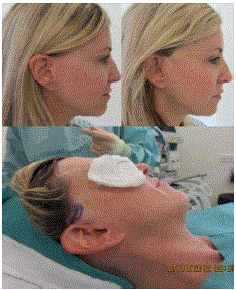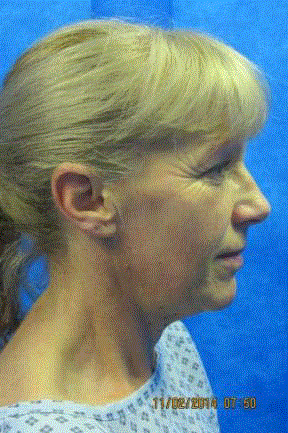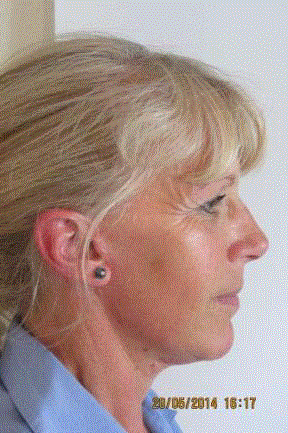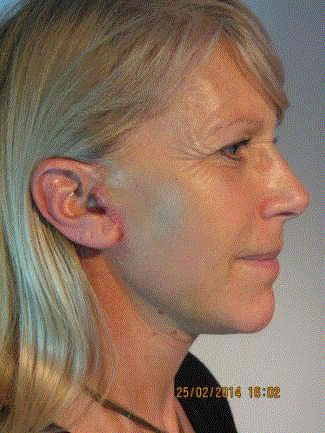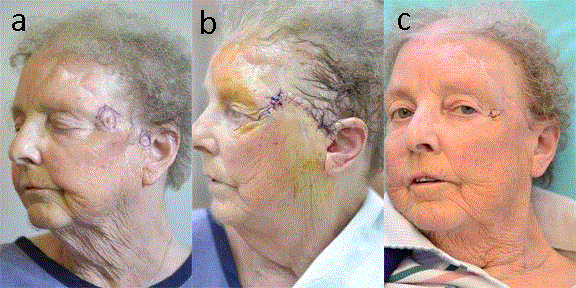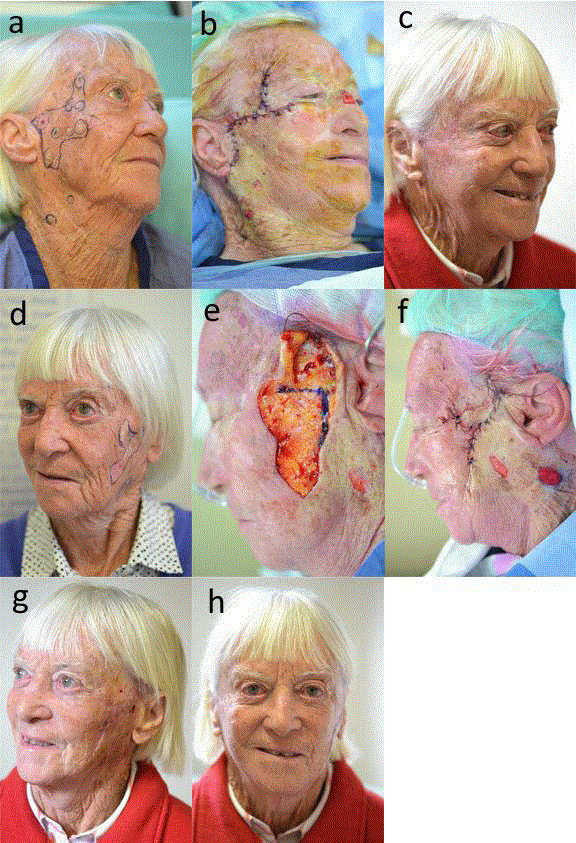Case Report
Aesthetica in Practice: The Flick Lift in Assisting Closure of Large Cutaneous Excisional Defects on Face
Michael F. Klaassen, James D. Frame* and Paul Levick
1Department of Plastic Surgeon, University of Auckland, New Zealand
2Department of Aesthetic Plastic Surgery, Anglia Ruskin University, UK
3Honorary Senior Lecturer Anglia Ruskin University, UK
*Corresponding author: James D. Frame, Department of Aesthetic Plastic Surgery, Anglia Ruskin University, Bishop Hall Lane, Chelmsford, Essex, UK
Published: 20 Oct, 2017
Cite this article as: Klaassen MF, Frame JD, Levick P.
Aesthetica in Practice: The Flick Lift in
Assisting Closure of Large Cutaneous
Excisional Defects on Face. Clin Surg.
2017; 2: 1684.
Abstract
Aesthetica is a term being used to describe the aesthetic reconstruction of congenital or acquired
deformity. Plastic Surgeons seek to deliver function, form and cosmesis during any reconstruction
but Cosmetic Surgery techniques commonly used in the private sector have evolved far in advance
of what is delivered in state funded hospitals, meaning that there is room to improve aesthetic
outcomes in select patients.
Extensive facial solar damage and malignancy is commonly seen in the elderly and if the surgery
option is to be taken then wide excisional defects can create a challenge for the reconstructive
surgeon. Primary closure may be impossible, local flaps may be under undue tension and sutures
may ‘cheese-wire’ the tissues. Skin grafts may succeed at the expense of poor cosmesis and delayed
healing at donor site.
The Superficial Musculo-Aponeurotic system (SMAS) is routinely used to relocate and provide
fixation of skin and superficial fat during face-lifting. This principle can be applied to take the
tension off skin closures particularly in the elderly patient, preferentially under local anaesthetic,
with very acceptable cosmetic outcomes.
We have adapted the minimally traumatic, low risk, flicklift technique used by Cosmetic Surgeons to
assist in tension free skin closure of large face excisional skin defects following skin cancer resection.
Keywords: Facelift; Flicklift; Skin cancer; Cosmetic surgery; Reconstruction face
Introduction
Aesthetica is a new and modern terminology that describes the application of cosmetic surgery
techniques to improve the appearance of congenital or acquired soft tissue defects [1,2]. Aesthetica
is performed at sites other than face of course, with examples in breast cancer reconstruction
with use of cosmetic implants, contralateral mastopexy or breast reduction and the modified
Brazilian Abdominoplasty for ‘no drains ‘massive weight loss (MWL) excisional surgery. Using
this definition, Aesthetica has by definition been frequently described in the literature in facial
reconstructive surgery and is indeed one of the reasons Plastic Surgery developed as a specialty,
following the work of McIndoe and others reconstructing major defects of face almost a century
ago. Facelifting has gone through decades of change but the pioneers have contributed greatly to our
understanding of anatomical planes [3,4]. Facelift for vascular malformation is but one example of
aesthetica [5]. Other authors including Klaassen and Pennington describe in clarity the use of local
flaps in reconstructive surgery to optimize appearance [6,7]. Local anaesthetic surgery also has clear
advantages in the elderly.
The flicklift is an adaptation of multiple techniques that combines benefits of the high SMAS
facelift, miniface lift with minimal undermining of skin to engage tissues and close deep space
during skin advancement and closure [8], and the Levick ‘One Stitch Hitch’ (Figures 1-4). The latter
is a 30 min procedure under local anaesthetic that involves a hemi-elliptical excision of skin from
just beneath the sideburn hairline in women. The dissection is onto superficial temporal fascia and
a 3/0 Nylon ‘figure of 8’ suture plicates the tissues. Amazingly it draws the tissues upwards and
backwards but as a criticism it leaves an anterior dog-ear in some patients–similar to that sometimes
seen after MACS lift [9]. To avoid this complication and attempt to provide more longevity to the
result, the scar is extended into the pre-auricular ‘scarless facelift’ crease perhaps extending below the tragus to just behind the lobule of the ear as required. An inverted L- incision is made in the SMAS at the level of the zygoma and a small
flap of SMAS is elevated. A 3/0 Ethibond (Ethicon) suture is used to
carry the SMAS flap up and over the zygoma and suture on masse to
the deep temporal fascia. The purchase is strong and gives immediate
improvement to jowels and midface. The effect, like with all facelift
techniques, depends on the relative relaxation of all tissues, including
skin, as post-operative swelling subsides and in relationship to the
relative slide and re-distribution of fat within the superficial and deep
facial fat compartments as the face is lifted [10]. The attraction of
less extensive dissection in the flicklift compared to more extensive
facelift is related to speed and ease of surgery and the closure of all
spaces which reduces risk of haematoma. These are also the principles
of mid-face composite lifting as espoused many times by Hamra over
the past 20 years. It is always preferred to do these procedures under
local anaesthetic and as day surgery [11,12].
In 1976, Mitz and Peyronie [13] described the SMAS layer and
this was further defined by Mendelson in 2001 [14]. Many other
senior authors have contributed to our understanding of facelift
surgery [15]. Following the now famous twins study by Alpert and
Hamra in 2009 it is clear that there is no single operative technique
that provides greater or longer lasting results in facial rejuvenation
[16]. In fact, many Surgeons have moved away from performing high
risk, deeper plane lifts because they have no longer lasting outcomes,
particularly to the neck [17] and they carry significant short and
longer term morbidity. Furthermore skin blood supply is improved
by retaining the skin attachment to SMAS as during a minimal
undermining, composite SMAS lift, so reducing risk of poor healing
and dead space haematoma or infection [18]. Mini face lifting and
revolumising with fat or hyaluronic acid, perhaps in conjunction with
skin resurfacing are the safer options with low risk and high reward
surgery.
Pennington has previously described the use of ‘skin only facelift’
as an advancement flap for preauricular defects. In the majority of
smaller skin defect reconstructions, primary closure or local flap
reconstructions are perfectly satisfactory, but to avoid grafting onto
larger wounds, deep tissue suspension is an adjunct to closure. In this
report we utilized SMAS, using the flicklift procedure described by
Frame and Levick in 2012 [10] and a ‘figure of 8’ suture, to advance
skin with superficial fat and reconstruct significant wide excisional
defects on face in two elderly women with basal cell and squamous
cell carcinomata.
Case Presentation
Case 1
An 81 year old lady (CS) with a history of previous facial basal
cell carcinomas presents with infiltrating basal cell carcinomata of her left temple and pre-auricular regions. Under local anaesthetic,
a wide excision of the affected skin areas led to a considerable size
of soft tissue defect. An anterior, inverted L- shaped SMAS flap was
suspended using a ‘figure of eight suture’ to the deep temporal fascia
providing support to enable tension free skin closure. The wounds
healed uneventfully and have given a rejuvenated look to the face
weeks later. A small residual dog-ear persisted at the left can thus and
this was revised under local anaesthetic at 6 weeks (Figure 5A-C).
Case 2
An 89-year-old female veteran tennis player (DDR) presented
with severe facial solar damage, Multiple Bowens SCC in-situ skin
lesions, within a wide field of dysplastic actinic keratoses (Figure
6A-H). There were very few options other than to consider graft if
local flaps could not be used. She has poor quality thin delicate skin
(Fitzpatrick 1), prone to cheese-wiring if sutured under tension. A
two stage local anaesthetic procedure was decided. Stage 1 was a wide
excision of right cheek lesions and repair of significant skin loss using
an anterior flicklift approach and inverted L-Shape SMAS flap (Figure
6A-C). The limited SMAS flap (Figure 6E) is raised and with a strong
‘figure of 8’ suture is lifted and anchored cephalad to deep temporal
fascia to take the tension off the advancing lateral cheek flap. Stage 2
was performed two weeks later by a similar wide excision and skin
flap repair of left cheek lesions utilizing SMAS deep tension support
using the flicklift principles (Figure 6D-F). At four weeks there is an
excellent result and an actual improvement of lower lid retraction and
less scleral show with good support to the lower eyelid.
Figure 1
Figure 2
Figure 3
Figure 4
Figure 5a-c
Figure 5a-c
A small residual dog-ear persisted at the left can thus and this
was revised under local anaesthetic at 6 weeks.
Discussion
Facelifting is one of the commonest aesthetic surgery procedures
and the majorities are performed by Plastic Surgeons trained to reconstruct soft tissue defects, but because of financial constraints
within most State Training Programmes, trainees no longer have
opportunities to see let alone operate on cosmetic surgery patients.
Most, younger plastic surgeons therefore are not exposed to some
of the modern techniques used in Cosmetic Surgery and this is
harmful to patients. Harold Gillies famously stated: 'No man (or
woman) can call themselves a plastic surgeon, unless they are adept
at both reconstructive and cosmetic surgery. Aesthetica is a concept
that encapsulates this Gillies principle. It is vitally important to train
Plastic Surgeons in all aspects of soft tissue reconstruction including
Cosmetic Surgery to give best possible outcomes especially where
there is facial disfigurement.
The Anterior Flicklift was originally developed by Frame and
Levick for improved rejuvenation of the midface and jowel and is
an extension of the ‘figure of 8’, one year lasting , ‘one stich hitch’
that had been performed but unpublished over many years by Levick
in Birmingham, UK. The anterior flicklift incision can be extended
downwards and behind the ear so that a small preauricular SMAS flap
can be transposed posteriorly over the mastoid to elevate the SMAS
and fix the position of jowel and anterior neck. This small flap also
supports the earlobe shape to prevent ‘pixie’ deformity. The elevation
of soft tissue attached to the SMAS layer is remarkable and there is no
need for deep tissue undermining.
For the past five years the first author (MK) used various variants
of the facelift flap for repair of cutaneous defects of the temple, preauricular, postauricular and lateral cheek regions and these
are published in his article on Aesthetica [7]. To reduce tension in
the skin closure a limited SMAS flap can easily be raised after soft
tissue excision of tumours down to but not through the SMAS layer.
With a strong ‘figure of 8’suture the SMAS flap is fixed cephalad so
taking the tension off the advancing lateral cheek flap. There may
be some temporary asymmetry of the face in the first few weeks but
this should resolve completely by four months. In bilateral staged
procedures, the asymmetry is less obvious. It was impressive how the
lower eyelid laxity was improved. We recommend this technique to
provide deep tension support when there is a need for a local flap
reconstruction under potential tension in the periauricular, lateral
cheek and zygomatic regions in elderly patients with some facial skin
laxity, because it is simple, effective and well tolerated under local
anaesthetic.
Figure 6a-h
Figure 6a-h
At four weeks there is an excellent result and an actual
improvement of lower lid retraction and less scleral show with good support
to the lower eyelid.
References
- Baumgarten AG. Encyclopaedia Britannica. Aesthetica. 2:1750-58.
- Definition of Aesthetica.
- Baker DC. Lateral SMASectomy. Plast Reconstr Surg. 1997;100:509-13.
- Robbins LB, Brothers DB, Marshall DM. Anterior SMAS plication for the treatment of prominent nasomandibular folds and restoration of normal cheek contour. PlastReconstr Surg. 1995;96:1279-87.
- Khan JI, Frame JD. Facelift surgery: An adjunct in the treatment of capillary malformations (port wine stains). Aesth Plast Surg. 1994;18:201-3.
- Frame JD, Frame JE. The Concept of Safer Facelifting. JCD. 2004;3;215-22.
- Klaassen MF, Brown E, Behan F. Simply Local Flaps. Springer (in press).
- Local Flap Reconstruction–A Practical Approach 2nd ed. Ed Pennington AJ, McGraw – Hill, Sydney, 2006.
- Tonnard P, Verpaele A, Monstrey S, Van Landuyt K, Blondeel P, Hamdi M, et al. Minimal access cranial suspension lift: a modified S-lift. Plast Reconstr Surg. 2002;109:2074-86.
- Saulis AS, Lautenschlanger EP, Mustoe TA. Biomechanical and viscoelastic properties of skin, SMAS and composite flaps as they pertain to rhytidectomy. PlastReconstr Surg. 2002;110:590-98.
- Frame J, Levick P. The Anterior Flicklift. 2012.
- Frame JD. Miniface lift and Revolumisation of the face. Presentation. ‘The Face’ Conference, Queenstown, New Zealand. 2017.
- Mitz V, Peyronie M. The superficial musculo-aponeurotic system (SMAS) in the parotid and cheek area. Plast Reconstr Surg. 1976;58:80-8.
- Mendelson BC. Surgery of the superficial musculo-aponeurotic system: principles of release, vectors, and fixation. PlastReconstr Surg. 2001;107:1545-52.
- Neligan PC. Plastic Surgery. 2017; 4th ed. Elsevier: ISBN: 978-1-4377-1733-4.
- Alpert BS, Baker DC, Hamra ST, Owsley JQ, Ramirez O, et al. Identical twin face lifts with differing techniques: a 10-year follow-up. Plast Reconstr Surg. 2009;123:1025-33.
- Jones BM, Lo S. How long does a facelift last? Objective and subjective measurements over a 5-year period. Plast Reconstr Surg. 2012;130(6):1317-27.
- Whetzel TP, Stevenson TR. The contribution of the SMAS to the blood supply in the lateral face lift flap. Plast Reconstr Surg. 1997;100:1011-18.

